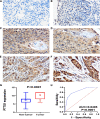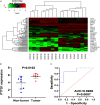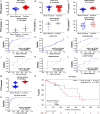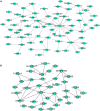The Clinical Significance and Potential Molecular Mechanism of PTTG1 in Esophageal Squamous Cell Carcinoma
- PMID: 33552118
- PMCID: PMC7863988
- DOI: 10.3389/fgene.2020.583085
The Clinical Significance and Potential Molecular Mechanism of PTTG1 in Esophageal Squamous Cell Carcinoma
Abstract
Esophageal squamous cell carcinoma (ESCC) is the major histological type of esophageal cancers worldwide. Transcription factor PTTG1 was seen highly expressed in a variety of tumors and was related to the degree of tumor differentiation, invasion, and metastasis. However, the clinical significance of PTTG1 had yet to be verified, and the mechanism of abnormal PTTG1 expression in ESCC was not clear. In this study, the comprehensive analysis and evaluation of PTTG1 expression in ESCC were completed by synthesizing in-house immunohistochemistry (IHC), clinical sample tissue RNA-seq (in-house RNA-seq), public high-throughput data, and literature data. We also explored the possible signaling pathways and target genes of PTTG1 in ESCC by combining the target genes of PTTG1 (displayed by ChIP-seq), differentially expressed genes (DEGs) of ESCC, and PTTG1-related genes, revealing the potential molecular mechanism of PTTG1 in ESCC. In the present study, PTTG1 protein and mRNA expression levels in ESCC tissues were all significantly higher than in non-cancerous tissues. The pool standard mean difference (SMD) of the overall PTTG1 expression was 1.17 (95% CI: 0.72-1.62, P < 0.01), and the area under curve (AUC) of the summary receiver operating characteristic (SROC) was 0.86 (95% CI: 0.83-0.89). By combining the target genes displayed by ChIP-seq of PTTG1, DEGs of ESCC, and PTTG1-related genes, it was observed that PTTG1 may interact with these genes through chemokines and cytokine signaling pathways. By constructing a protein-protein interaction (PPI) network and combining ChIP-seq data, we obtained four PTTG1 potential target genes, SPTAN1, SLC25A17, IKBKB, and ERH. The gene expression of PTTG1 had a strong positive correlation with SLC25A17 and ERH, which suggested that PTTG1 might positively regulate the expression of these two genes. In summary, the high expression of PTTG1 may play an important role in the formation of ESCC. These roles may be completed by PTTG1 regulating the downstream target genes SLC25A17 and ERH.
Keywords: PTTG1; RNA sequencing; esophageal squamous cell carcinoma; tissue microarray; transcription factor.
Copyright © 2021 Chen, Zhou, Zhang, He, Huang, Dang, Yang, Liu, Fu, Mo, Tang, Li, Li, Yang, Ma, Yang and Chen.
Conflict of interest statement
The authors declare that the research was conducted in the absence of any commercial or financial relationships that could be construed as a potential conflict of interest.
Figures











Similar articles
-
Overexpression of UBE2C in esophageal squamous cell carcinoma tissues and molecular analysis.BMC Cancer. 2021 Sep 6;21(1):996. doi: 10.1186/s12885-021-08634-6. BMC Cancer. 2021. PMID: 34488675 Free PMC article.
-
PTTG1 cooperated with GLI1 leads to epithelial-mesenchymal transition in esophageal squamous cell cancer.Oncotarget. 2017 Sep 27;8(54):92388-92400. doi: 10.18632/oncotarget.21343. eCollection 2017 Nov 3. Oncotarget. 2017. PMID: 29190924 Free PMC article.
-
Integrative genomics analysis of hub genes and their relationship with prognosis and signaling pathways in esophageal squamous cell carcinoma.Mol Med Rep. 2019 Oct;20(4):3649-3660. doi: 10.3892/mmr.2019.10608. Epub 2019 Aug 23. Mol Med Rep. 2019. PMID: 31485619 Free PMC article.
-
The Pseudogene PTTG3P Promotes Cell Migration and Invasion in Esophageal Squamous Cell Carcinoma.Open Med (Wars). 2019 Jun 30;14:516-522. doi: 10.1515/med-2019-0057. eCollection 2019. Open Med (Wars). 2019. PMID: 31346548 Free PMC article.
-
Upregulated expression of PTTG1 is associated with progression of pancreatic cancer.J Gastrointest Oncol. 2024 Feb 29;15(1):435-457. doi: 10.21037/jgo-23-979. Epub 2024 Feb 20. J Gastrointest Oncol. 2024. PMID: 38482253 Free PMC article.
Cited by
-
Multiomics data analyses to identify SLC25A17 as a novel biomarker to predict the prognosis and immune microenvironment in head and neck squamous cell carcinoma.BMC Bioinformatics. 2023 Jun 29;24(1):269. doi: 10.1186/s12859-023-05399-6. BMC Bioinformatics. 2023. PMID: 37386359 Free PMC article.
-
Mitochondrial energy metabolism correlates with an immunosuppressive tumor microenvironment and poor prognosis in esophageal squamous cell carcinoma.Comput Struct Biotechnol J. 2023 Aug 24;21:4118-4133. doi: 10.1016/j.csbj.2023.08.022. eCollection 2023. Comput Struct Biotechnol J. 2023. PMID: 37664173 Free PMC article.
-
Smarca4 deficiency induces Pttg1 oncogene upregulation and hyperproliferation of tubular and interstitial cells during kidney development.Front Cell Dev Biol. 2023 Sep 4;11:1233317. doi: 10.3389/fcell.2023.1233317. eCollection 2023. Front Cell Dev Biol. 2023. PMID: 37727504 Free PMC article.
-
USP10 promotes migration and cisplatin resistance in esophageal squamous cell carcinoma cells.Med Oncol. 2023 Dec 27;41(1):33. doi: 10.1007/s12032-023-02272-7. Med Oncol. 2023. PMID: 38150085
-
Exploring the role of key gene PTTG1 in clear cell renal carcinoma based on bioinformatics analysis and In-vitro cell experiments.Toxicol Res (Camb). 2025 Jun 17;14(3):tfaf078. doi: 10.1093/toxres/tfaf078. eCollection 2025 Jun. Toxicol Res (Camb). 2025. PMID: 40585419
References
LinkOut - more resources
Full Text Sources
Other Literature Sources
Molecular Biology Databases

